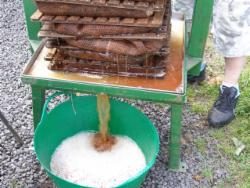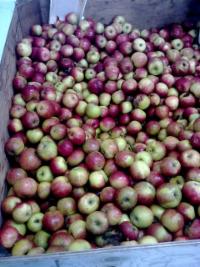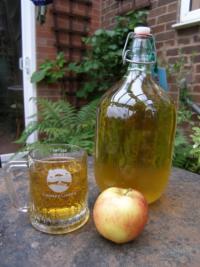 Perhaps the largest contribution orchards have made to rural life is the pressing of their fruit to produce cider and perry. For centuries cider was the drink of the rural masses as well as during certain periods the tipple of the gentry. It was made on a vast scale and prior to the 1930’s most farms made their own.
Perhaps the largest contribution orchards have made to rural life is the pressing of their fruit to produce cider and perry. For centuries cider was the drink of the rural masses as well as during certain periods the tipple of the gentry. It was made on a vast scale and prior to the 1930’s most farms made their own.
Further back in history farm labourers were part paid in cider with a daily allowance of several pints. It was said that the reputation of your cider would influence the desire of pickers and seasonal labourers to work for you. If the farm up the road made a better cider they would offer their services there instead. In 1887 payment in alcoholic beverages was made illegal through a Truck Amendment Act that extended the protections given to manual workers, although the practice no doubt continued unofficially for decades afterwards.
For much of history cider or beer was safer to drink than the water, the fermentation process killing off any pathogens. In those parts of the country where apples were far more prevalent than hops cider was the mainstay of rural refreshment. Cider’s great advantage over beer is that it is a cold fermentation process, whereas beer needs to be heated using considerable energy: cider can therefore be thought of as a much more environmentally friendly drink!
In the eighteenth century cider was the finest drink you could serve to your guests, in some circles being held in the sort of esteem we might reserve for fine wines today. In many rural shires cider would have been the most widely drunk refreshment. All this changed during the economic depression following the Second World War when the big brewing companies sent agents around the country offering cash to poor farmers to buy up their cider presses. These were then destroyed, thus killing off the competition and monopolising the market to begin the domination of the multi-national brewing conglomerates that exist today.
By the 1980’s cider had associations with underage drinking or tramps sleeping it off on park benches. Never had such a once-esteemed drink fallen so far from grace. The reasons for this were several-fold including the growth in popularity of wine from the 1970’s onwards, the real ale movement and perhaps simply that the mass-produced, poor quality, fizzy, sweet cider available on the market was giving the drink a bad name.
Today, thankfully, cider is undergoing something of a resurgence with an increase in artisan cider and perry makers reverting to small-scale local production and introducing the public to a much better-tasting drink. A spin off from the popularity of brands such as Magners has introduced a new generation to cider, some of whom then go on to seek out alternative craft ciders and perrys.
If you buy cider made from the apples of a good old fashioned orchard you are supporting the retention of these wonderful landscape features and the rich wildlife that goes with them. You are also supporting that rare species the native craft cider maker. Seek out and support your local producer, put your pounds back into the local economy and maintain a traditional landscape at the same time.
In many an orchard in autumn you will see countless apples rotting on the ground, such is the madness of modern agricultural economics where whole crops are considered not up to the grade or simply not worth picking. The beauty of cider is that it matters not how lop sided, large or small the apples were, what colour tone the skin had or if there was the odd blotch here and there. So cider making is a great use of all those apples that might otherwise be rejected, wasted or left to rot.
 Home Brew
Home BrewWhen it comes to making your own, cider is easier to home brew than wine or beer. It really is suited to a rough and ready garden shed style of brewing. Combine the simplest of ingredients – a quantity of apples, a scratter and press to extract the juice, a little yeast, a demijohn or barrel with an air lock – then just sit back and wait. It is a myth that cider is only made from cider apples. Whilst some parts of the West Country and Herefordshire have a tradition of very specific cider apples varieties, in other parts of the country fine cider is made from the juice of cookers and eaters, so any apple can be used.
There is of course a difference between fizzy industrialised cider and proper craft or homemade cider. The latter will be flatter, although you can get some sparkle in it by what is known as “bottle conditioningâ€. It will perhaps be drier and sharper to the taste. One of the issues with cider as a subject is that it is a very broad spectrum drink: there are some superb ciders being made as well as some incredibly rough, almost truly dreadful brews and every shade between the two. Therefore to say you do or do not like cider is dependent upon what you have tried.
If you do get the home brew bug your results will vary, for factors like the weather, the amount of sunshine the apples received while growing, soil type and rainfall will all influence the juice and thus the cider. If you do have a slightly disappointing batch, do not throw it away. Warmed up with a little honey, some spices, a slug of apple juice and a few slices of orange and you can turn a mediocre cider into great mulled cider.
 And it’s even good for you
And it’s even good for youAs if all of the above were not good enough reason to partake of a glass of cider, there is now scientific evidence that it could even be good for you. Trials by the Institute of Food Research have found that half a pint of traditional English cider is high in antioxidants on a par with a glass of red wine, and that in moderation (within the recommended units per day) a glass of cider can have health benefits.
John Worlidge in 1676 wrote of cider “Constant use of this liquor hath been found by long experience to avail much to health and long life, preserving the drinkers of it in their full strength and vigour even to very old age†and this has now been backed up by modern research. Cheers!